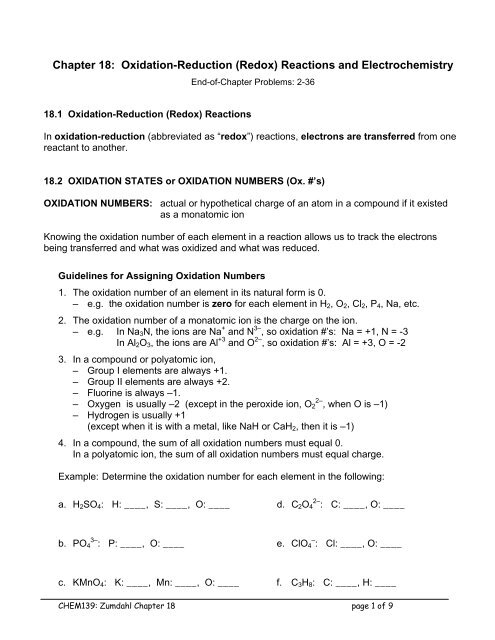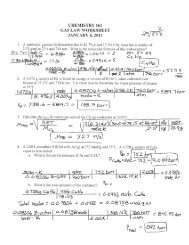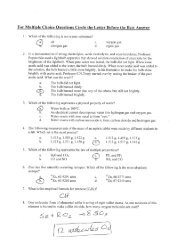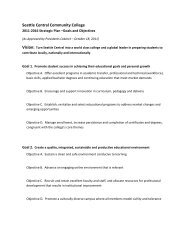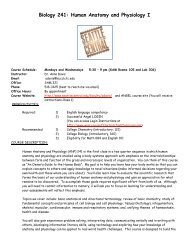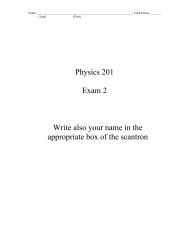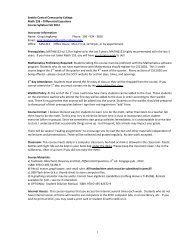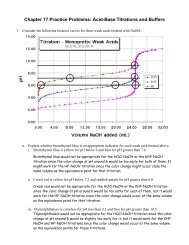Chapter 18: Oxidation-Reduction (Redox) Reactions and ...
Chapter 18: Oxidation-Reduction (Redox) Reactions and ...
Chapter 18: Oxidation-Reduction (Redox) Reactions and ...
- No tags were found...
You also want an ePaper? Increase the reach of your titles
YUMPU automatically turns print PDFs into web optimized ePapers that Google loves.
<strong>Chapter</strong> <strong>18</strong>: <strong>Oxidation</strong>-<strong>Reduction</strong> (<strong>Redox</strong>) <strong>Reactions</strong> <strong>and</strong> ElectrochemistryEnd-of-<strong>Chapter</strong> Problems: 2-36<strong>18</strong>.1 <strong>Oxidation</strong>-<strong>Reduction</strong> (<strong>Redox</strong>) <strong>Reactions</strong>In oxidation-reduction (abbreviated as “redox”) reactions, electrons are transferred from onereactant to another.<strong>18</strong>.2 OXIDATION STATES or OXIDATION NUMBERS (Ox. #’s)OXIDATION NUMBERS: actual or hypothetical charge of an atom in a compound if it existedas a monatomic ionKnowing the oxidation number of each element in a reaction allows us to track the electronsbeing transferred <strong>and</strong> what was oxidized <strong>and</strong> what was reduced.Guidelines for Assigning <strong>Oxidation</strong> Numbers1. The oxidation number of an element in its natural form is 0.– e.g. the oxidation number is zero for each element in H 2 , O 2 , Cl 2 , P 4 , Na, etc.2. The oxidation number of a monatomic ion is the charge on the ion.– e.g. In Na 3 N, the ions are Na + <strong>and</strong> N 3– , so oxidation #’s: Na = +1, N = -3In Al 2 O 3 , the ions are Al +3 <strong>and</strong> O 2– , so oxidation #’s: Al = +3, O = -23. In a compound or polyatomic ion,– Group I elements are always +1.– Group II elements are always +2.– Fluorine is always –1.– Oxygen is usually –2 (except in the peroxide ion, O 2 2– , when O is –1)– Hydrogen is usually +1(except when it is with a metal, like NaH or CaH 2 , then it is –1)4. In a compound, the sum of all oxidation numbers must equal 0.In a polyatomic ion, the sum of all oxidation numbers must equal charge.Example: Determine the oxidation number for each element in the following:a. H 2 SO 4 : H: ____, S: ____, O: ____ d. C 2 O 4 2– : C: ____, O: ____b. PO 4 3– : P: ____, O: ____ e. ClO 4 – : Cl: ____, O: ____c. KMnO 4 : K: ____, Mn: ____, O: ____ f. C 3 H 8 : C: ____, H: ____CHEM139: Zumdahl <strong>Chapter</strong> <strong>18</strong> page 1 of 9
For each of the following,i. Identify the type of reaction using the letters designated below:– Combination (C) – Double Replacement/Precipitation (P)– Decomposition (D) – Double Replacement/Neutralization (N)– Single Replacement (SR) – Combustion (B)ii. Balance the equationiii. Determine the oxidation number for each atom in the reaction, <strong>and</strong> indicate if it is a redoxreaction. (If the oxidation numbers change for several atoms, it is a redox reaction.)TYPE<strong>Redox</strong>?_____ Y N a. ____ Cr(s) + ____ S 8 (s)Δ⎯ ⎯ →____ Cr 2 S 3 (s)_____ Y N b. ____ Fe(s) + ____ H 2 SO 4 (aq) → ____ H 2 (g) + ____ Fe 2 (SO 4 ) 3 (aq)_____ Y N c. ____ Li 2 CO 3 (aq) + _____ AlCl 3 (aq) → ____ Al 2 (CO 3 ) 3 (s) + ____ LiCl(aq)_____ Y N d. ____ NaHCO 3 (s)Δ⎯ ⎯ →____ Na 2 CO 3 (s) + ____ H 2 O(g) + ____ CO 2 (g)_____ Y N e. ____ C 3 H 8 O(l) + ____ O 2 (g)Δ⎯ ⎯ →____ H 2 O(g) + ____ CO 2 (g)_____ Y N f. ____ KOH(aq) + ____ H 3 PO 4 (aq) → ____ H 2 O(l) + ____ K 3 PO 4 (aq)_____ Y N g. ____ Na(s) + ____ H 2 O(l) → ____ H 2 (g) + ____ NaOH(aq)_____ Y N h. ____ KClO 3 (s)Δ⎯ ⎯ →____ KCl(s) + ____ O 2 (g)CHEM139: Zumdahl <strong>Chapter</strong> <strong>18</strong> page 2 of 9
Consider the following redox (electron-transfer) reactions:<strong>Oxidation</strong> half-reaction:Zn(s) → Zn 2+ (aq) + 2 e −<strong>Reduction</strong> half-reaction: Cu 2+ (aq) + 2 e −→ Cu(s)In this redox reaction, the zinc metal strip, Zn(s), loses 2 electrons to form zinc ion, Zn 2+ (aq)while the copper(II) ion, Cu 2+ (aq), gains the 2 electrons from the zinc to form copper granules,Cu(s), the fuzzy black solid forming on the zinc strip.Notice that when Zn(s) loses electrons, its oxidation number increases, <strong>and</strong>when Cu 2+ (aq) gains electrons, its oxidation number decreases.– Electrons are negatively charged, so charge gets confusing because the more electrons, thelower the charge. Think of electrons the same way you think of debt – the more debt youhave, the lower your net worth → gaining electrons results in the charge (<strong>and</strong> oxidationnumber) actually go down.<strong>Oxidation</strong>: process of losing electrons (oxidation number ↑)<strong>Reduction</strong>: process of gaining electrons (oxidation number ↓)In a redox reaction– One reactant Loses Electrons/is Oxidized (LEO)– Another reactant Gains Electrons/is Reduced (GER)An easy way to remember is “LEO the lion goes GER!”CHEM139: Zumdahl <strong>Chapter</strong> <strong>18</strong> page 3 of 9
c. C 2 H 4 (g) + O 2 (g)Δ⎯ ⎯ → CO 2 (g) + H 2 O(g)What is oxidized? ______________________ What is reduced? ______________________The oxidizing agent is __________________, <strong>and</strong> the reducing agent is __________________.The number of electrons transferred is ______,d. Fe 2 O 3 (s) + CO(g) → Fe(s) + CO 2 (g)What is oxidized? ______________________ What is reduced? ______________________The oxidizing agent is __________________, <strong>and</strong> the reducing agent is __________________.The number of electrons transferred is ______,h. Ca(s) + H 2 O(l) → Ca(OH) 2 (aq) + H 2 (g)What is oxidized? ______________________ What is reduced? ______________________The oxidizing agent is __________________, <strong>and</strong> the reducing agent is __________________.The number of electrons transferred is ______,Note: In this reaction, only half of the hydrogen atoms were reduced; thus, not every atomof an element may be oxidized or reduced in a redox reaction.CHEM139: Zumdahl <strong>Chapter</strong> <strong>18</strong> page 5 of 9
<strong>18</strong>.5 Electrochemistry: An Introductionelectrochemistry: study of converting chemical <strong>and</strong> electrical energyWhen redox reactions occur in solutions, the electrons transfer in the solution, so no work can bedone with the electron flow.However, if we can separate the oxidizing agent from the reducing agent <strong>and</strong> force the electrontransfer to occur through a wire, the flow of electrons—i.e., the electrical current—producedfrom the reaction can be used to do work → electrochemical cell.– Electrochemical cells convert the chemical energy of a spontaneous redox reaction intoelectrical energy (e.g. batteries).There are two types of electrochemical cells:1. voltaic cells (also called galvanic cells): cells in which a spontaneous chemical reactiongenerates an electrical current2. electrolytic cells: cells in which an electrical current runs a nonspontaneous reactionVOLTAIC (or GALVANIC) CELLSConsider the following voltaic cell consisting of a piece of Zn metal dipped in a ZnSO 4 (aq)—solution (the Zn half cell) <strong>and</strong> Cu metal dipped in a CuSO 4 solution (the Cu half cell):<strong>Oxidation</strong> half-reaction occurs at anode: Zn(s) → Zn 2+ (aq) + 2 e −<strong>Reduction</strong> half-reaction occurs at cathode: Cu 2+ (aq) + 2 e − → Cu(s)– Because Zn is more active than Cu, electrons flow from the Zn half cell to the Cu half cell.– A salt bridge allows ions to flow <strong>and</strong> prevent charge buildups that impede the electron flow.– As more Zn 2+ ions are produced, the overall charge in the Zn cell becomes too positive.– As more Cu 2+ are reduced to Cu, more SO 4 2- than Cu 2+ ions are present → too negative.CHEM139: Zumdahl <strong>Chapter</strong> <strong>18</strong> page 6 of 9
<strong>18</strong>.6 BATTERIESDRY-CELL BATTERIES– Flashlight, AA, <strong>and</strong> AAA batteries are examples of dry-cell batteries that do not contain largeamounts of water.Alkaline dry-cell batteries consist of a Zn case withOH − , a base (hence the name alkaline) that serves asthe anode <strong>and</strong> a carbon rod <strong>and</strong> MnO 2 paste thatserves as the cathode:Anode half-reaction (oxidation):Zn(s) + 2 OH − (aq) → Zn(OH) 2 (s) + 2 e −Cathode half-reaction (reduction):2 MnO 2 (s) + 2 H 2 O(l) + 2 e − →2 MnO(OH)(s) + 2 OH − (aq)The driving force causing electrons to flow is called the voltage (or potential difference).– For these two half-reactions product above, the voltage is produced is 1.5 V,so higher voltages would require two or more batteries to be connected in a series.LEAD-ACID STORAGE BATTERIES– Common automobile batteries are examples of lead-acid storage batteries.– They consist of six electrochemical cells wired in series, with each cell producing 2 V for atotal of 12 V.– The anode (negative electrode) consists of a grid made of porous Pb while the cathode(positive electrode) consists of PbO 2 , with both anode <strong>and</strong> cathode immersed in H 2 SO 4 (aq)Anode half-reaction (oxidation):Pb(s) + SO 4 −2 (aq) → PbSO 4 (s) + 2 e −Cathode half-reaction (reduction):PbO 2 (s) + 4H + (aq) + SO −2 4 (aq) + 2e − →PbSO 4 (s) + 2 H 2 O(l)Note that the product for both half-reactions is PbSO 4 , so if the battery runs for a long timewithout recharging, the PbSO 4 builds up, <strong>and</strong> the battery goes dead.→ However, the alternator in a car produces an electrical current that reverses the half-reactionsshown above, converting the PbSO 4 back into Pb <strong>and</strong> PbO 2 , <strong>and</strong> thus, recharging the battery.– Thus, electrical currents can be used to reverse spontaneous redox reactions.→ This process is called electrolysis.CHEM139: Zumdahl <strong>Chapter</strong> <strong>18</strong> page 7 of 9
<strong>18</strong>.8 Electrolysis: process of using electrical energy to cause a nonspontaneous redox reactionelectrolytic cell:– the type of cell where electrolysis occurs– For example, an electrolytic cell can be used to produce silver-plated objects.Electrolysis of WaterElectrolysis can also be used to convert water to H 2<strong>and</strong> O 2 gas:Anode half-reaction (oxidation):2 H 2 O(l) → O 2 (g) + 4 H + (aq) + 4 e –Cathode half-reaction (reduction):2 H 2 O(l) + 2 e – → H 2 (g) + 2 OH − (aq)This process is important because the promise ofhydrogen fuel cell technology depends on anabundant supply of H 2 gas.– While large quantities of H 2 gas do no exist, wehave an abundant supply of water which can beconverted to H 2 gas using electrolysis.CHEM139: Zumdahl <strong>Chapter</strong> <strong>18</strong> page 8 of 9
FUEL CELLSfuel cell: a voltaic cell that relieson oxidizing a fuel (e.g. H 2 ) togenerate electrical energyFuel cells used in electric vehiclesuse acidic electrolytes <strong>and</strong> aproton exchange member (PEM).The half reaction at the anoderesults from H 2 fuel diffusing(moving) into a porous graphiteelectrode, where it’s oxidized to H +ions:anode: 2 H 2 (g) → 4 H + (aq) + 4 e –Electrons are pushed through anexternal circuit by a cell potential ofabout 0.7 V, about half the cellpotential for the reaction,2 H 2 (g) + O 2 (g) → 2 H 2 O(l)As electrons get pumped out of thecell through the anode, H+ ionsmigrate through the PEM to thecathode, where they help in thereduction of O 2 from air:cathode: O 2 (g) + 4H + (aq) + 4 e – → 2H 2 O(l)An individual PEM fuel cell produces a potential of about 1.0 V, less than a 1.5V AA battery, buthundreds of these cells can be assembled into fuel cell stacks that can produce 100 kW ofelectrical power, enough to power a car to run about 100 mph.CHEM139: Zumdahl <strong>Chapter</strong> <strong>18</strong> page 9 of 9


